The Training Process consists of well-planned step by step process that should be adopted while deciding a training program.
Training is an investment made by an organization with the objective of achieving some desired results. If the training is effective then it can be very profitable for the organization.
Training Process
Below are the steps involved in the training process:
- Needs Assessment
- Defining Training Objective
- Designing a Training Program
- Implementation of the Training Program
- Evaluation and Follow up

Needs Assessment
The first step in the training process is to assess the need for training the employees. It analysis what are the long term requirements of the organization and what does the organization expects from the employees.
If there is a mismatch between the skills and knowledge required, it means there is a learning gap. To assess this learning gap below three elements is closely examined.
- Organization analysis: The objectives of the organization are studied. The end result that a company wants to achieve is examined in context to how it uses its resources to achieve the same. Organizations’ internal and environment is also considered.
- Operation Analysis: A job requires a combination of different activities for successful completion. Operation analysis focuses on the needs, skills, knowledge, and attitude required to efficiently complete the job.
- Person analysis: In-person analysis the focus is on the employee who has to perform the job. It is analyzed whether the performance of the employee is satisfactory and he is being able to achieve the organizational goal.
Defining Training Objective
After deriving the learning gap organizations should define the learning objective. Goals and objective of training becomes the foundation of the training initiatives.
Hence determining the training objectives gives a direction to the entire learning program.
Designing a Training Program
Once the objective of the training program is determined, it is time to analyze the factors that need to be considered while designing a training program.
- Who will be the trainer: As per the skill and knowledge required for effective training; it should be decided upon who will conduct the training program. It can be a supervisor, university faculty, Industrialist, HR staff, consultants, etc.
- Who needs to be trained: It is to be decided who all needs to be trained to fill the learning gap. It can be on the basis of self-motivation, recommendation by supervisors of HR department itself.
- Training Methods: Trainer should have complete information about the participants and their profile so that he can choose the learning methods that best suits their requirements. The training content is prepared based on the specific areas that need development.
Implementation of the Training Program
Refers to putting the training plan into action. There should be a proper environment created which is conducive to learning. It should be preferably a participative approach and trainer should promote role-playing and interactive games to keep the trainees involved
Evaluation and Follow up
Training evaluation is done to check whether the goals and objectives of the training have been achieved or not. Feedback needs to be taken from the participants on the training results.
A follow up can be done by asking the supervisors whether the participants are applying the skills learned in the learning program on their day to day job.
Systematic Approach to Training & Development
To operate training in a systematic manner, it has to cover inter related stages and processes as graphically depicted in the figure below:
- Organisation’s Aim
- Analysing Training Needs
- Setting aims and learning objectives
- Designing Training strategy
- Implementing Training Strategy
- Validation: Internal or External
Organisation’s Aim
Understanding the organisation’s aims and needs and how the aims are met by range of jobs that exist in the organisation
Analysing Training Needs
Finding out what people need to learn
- Analysing the knowledge, skills and attitudes/behaviours that each job requires;
- Assessing the degree of competence of job-holders to meet those requirements
Setting aims and learning objectives
Specifying what trainees should be able to do as a result of training.
Designing Training strategy
Deciding on a strategy to meet training needs, e.g., by designing courses/modules, suggesting various methodologies, deciding key learning points trainees must grasp and also sending some learning material (preview) to trainees.
Implementing Training Strategy
Putting the training into practice.
Validation: Internal or External
Establishing and assessing the quality and effectiveness of training.
Reference
- R. P. Lynton, U. Prateek, “Training for Development”, Sage Publications 2002.
- Goldstein, “Training in Organizations”, Burr Ridge: McGraw Hill, Irwin, 1999
- Fitzgerald, W. (1992). Training versus development. Training and Development, 46(5), 81-84.
Go On, Share article with Friends
Did we miss something in Human Resource Management Tutorial? Come on! Tell us what you think about our article on Training Process: 5 Step process | Explained [2020] in the comments section.
Human Resources Tutorial
(Click on Topic to Read)






